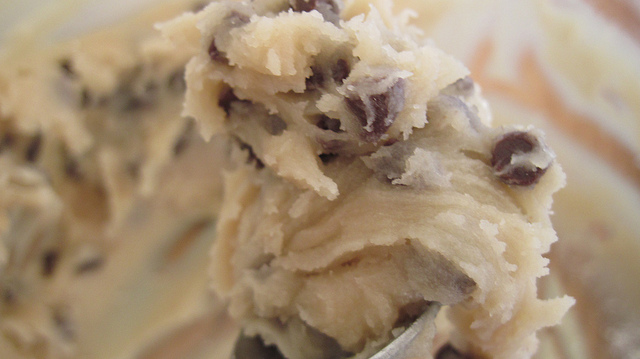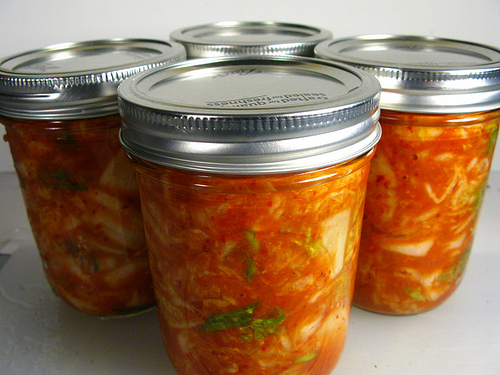A good year-end trend list should do two things simultaneously: confirm the conscientious reader’s suspicions while providing a few surprise nuggets. Sustainable food is a vast category with many opportunities for interpretation, so what I offer up here is an entirely subjective list of favorites. In other words: These are just a few of the things that have caught my attention and held it for longer than usual this year.
You’ll notice I’ve left urban gardening and foraging off the list (sacrilege!). That’s not because they’re not very popular; in fact, it’s precisely because they’re so popular. To me, not much is left to say about either. Maybe you’ll disagree — I’d love to hear any and all thoughts in the comments below.
Bye-bye bottles!
 Photo: Taylor McConnellI always get a little giddy when a server offers me a carafe of house-made bubbly water. Not only does it feel like a fancy indulgence, but I know that the water has been carbonated there, in the restaurant, meaning no one has used fossil fuels to ship a heavy glass bottle filled with water (of all things!) across the world on my behalf. This year, however, I’ve noticed a number of restaurants have also begun offering wine on tap. It’s true! Some genius finally had the wherewithal to begin putting vino in 20-liter stainless steel containers similar to those used for soda syrup. The result is much less waste (of bottles, but also of wine, which tends to deteriorate quickly once a bottle has been opened), and a much smaller carbon footprint. I’ll raise a glass to that!
Photo: Taylor McConnellI always get a little giddy when a server offers me a carafe of house-made bubbly water. Not only does it feel like a fancy indulgence, but I know that the water has been carbonated there, in the restaurant, meaning no one has used fossil fuels to ship a heavy glass bottle filled with water (of all things!) across the world on my behalf. This year, however, I’ve noticed a number of restaurants have also begun offering wine on tap. It’s true! Some genius finally had the wherewithal to begin putting vino in 20-liter stainless steel containers similar to those used for soda syrup. The result is much less waste (of bottles, but also of wine, which tends to deteriorate quickly once a bottle has been opened), and a much smaller carbon footprint. I’ll raise a glass to that!
Root-to-stem cooking
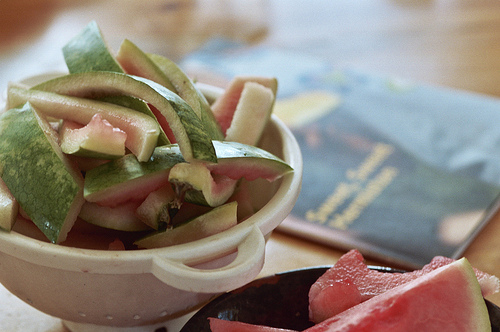 Save watermelon rinds for pickling. Photo: Sarah GilbertA New York Times article from earlier this year called “That’s Not Trash, That’s Dinner” did a great job of tracking the super-green practice of cooking with oft-overlooked parts of typical fruits and vegetables. The trend, which obviously takes its name from nose-to-tail butchery (another trend that’s going strong, but isn’t exactly new unless you count the fact that people are applying the philosophy to fish), applies to everything from the ultra-utilitarian beet, carrot, and turnip tops, to chive flowers and cilantro roots. It also goes hand-in-hand with much of the preservation techniques that are making a comeback these days, as well. Case in point: pickled watermelon rind. My favorite example? The odd-sounding but enchantingly delicate peach leaf ice cream.
Save watermelon rinds for pickling. Photo: Sarah GilbertA New York Times article from earlier this year called “That’s Not Trash, That’s Dinner” did a great job of tracking the super-green practice of cooking with oft-overlooked parts of typical fruits and vegetables. The trend, which obviously takes its name from nose-to-tail butchery (another trend that’s going strong, but isn’t exactly new unless you count the fact that people are applying the philosophy to fish), applies to everything from the ultra-utilitarian beet, carrot, and turnip tops, to chive flowers and cilantro roots. It also goes hand-in-hand with much of the preservation techniques that are making a comeback these days, as well. Case in point: pickled watermelon rind. My favorite example? The odd-sounding but enchantingly delicate peach leaf ice cream.
Bugs on your plate! (not the kind that will get you your money back)
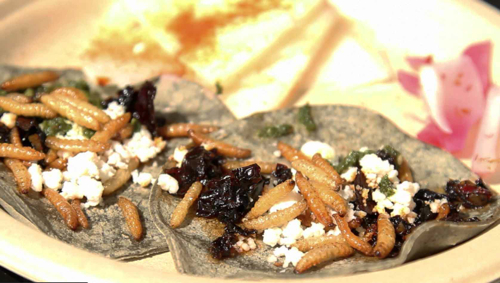 Wax moth larvae tacos.With demand for all things steak-and-potato rising dramatically in fast-developing nations like China and India, and biofuel production competing for land where we raise the grain necessary to feed livestock, it’s clear that meat as we know it is quickly becoming a precious commodity. Similar to the smart offal trend that has been slowly infiltrating high-end restaurants around the nation, bug eating is most likely to take off among those with adventuresome personalities and a considerable tolerance for unexpected food textures. I haven’t made it over the bug-eating hump just yet, but I hope to get a chance to try a moth larvae taco from this pop-up restaurant we featured on Grist someday soon.
Wax moth larvae tacos.With demand for all things steak-and-potato rising dramatically in fast-developing nations like China and India, and biofuel production competing for land where we raise the grain necessary to feed livestock, it’s clear that meat as we know it is quickly becoming a precious commodity. Similar to the smart offal trend that has been slowly infiltrating high-end restaurants around the nation, bug eating is most likely to take off among those with adventuresome personalities and a considerable tolerance for unexpected food textures. I haven’t made it over the bug-eating hump just yet, but I hope to get a chance to try a moth larvae taco from this pop-up restaurant we featured on Grist someday soon.
A-Swap-bop-a-loo-lop-a-swap-bam-boom
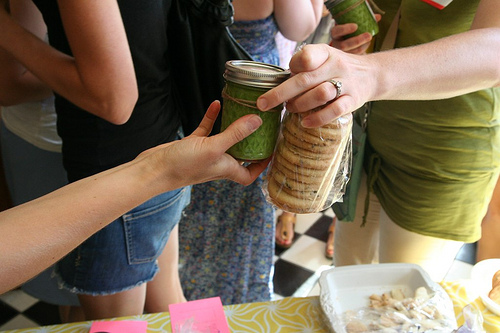 Photo: reneemcaIt may be the face-to-face community aspect or the fact that swapping allows eaters to cut out the middleman and share DIY tricks and tips, but crop swaps, meal swaps, and artisan food swaps were everywhere this year. In other words, if you managed to stay clear of the swapping frenzy that was 2011, it was probably on purpose. And I bet you probably hate family-style restaurants, too, don’t you?
Photo: reneemcaIt may be the face-to-face community aspect or the fact that swapping allows eaters to cut out the middleman and share DIY tricks and tips, but crop swaps, meal swaps, and artisan food swaps were everywhere this year. In other words, if you managed to stay clear of the swapping frenzy that was 2011, it was probably on purpose. And I bet you probably hate family-style restaurants, too, don’t you?
More types of CSAs, more often
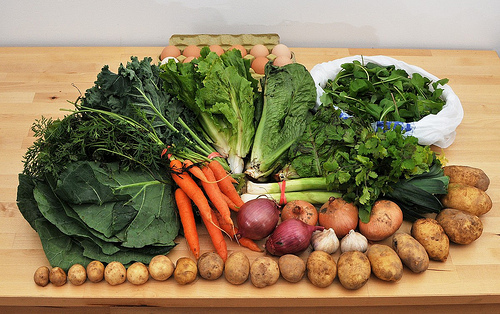 A November CSA box from New York. Photo: Steven SeveringhausCommunity Supported Agriculture (CSA) has come a long way in the last decade. Not only has this once-foreign concept of buying directly from farmers and ranchers by way of regular drop-offs and pick-ups become a household term, but it can now be applied in more contexts. 2011 has seen produce CSAs in cold places expand their growing cycle thanks to simple technology like hoop houses and greenhouses. And there are now more and more things you can get direct from producers. In the Bay Area, where I live, we’ve had several awesome meat and egg CSAs for a while — but 2011 brought with it two new sustainable seafood “boxes.” One is just for Google employees (not a tiny group, mind you) and another is open to the public.
A November CSA box from New York. Photo: Steven SeveringhausCommunity Supported Agriculture (CSA) has come a long way in the last decade. Not only has this once-foreign concept of buying directly from farmers and ranchers by way of regular drop-offs and pick-ups become a household term, but it can now be applied in more contexts. 2011 has seen produce CSAs in cold places expand their growing cycle thanks to simple technology like hoop houses and greenhouses. And there are now more and more things you can get direct from producers. In the Bay Area, where I live, we’ve had several awesome meat and egg CSAs for a while — but 2011 brought with it two new sustainable seafood “boxes.” One is just for Google employees (not a tiny group, mind you) and another is open to the public.
Soon, there may be nothing you won’t be able to buy directly from farmers. There’s now a coffee CSA, for instance. And, as demand for local and organic grains has increased, so have grain-focused CSAs. Although there aren’t many, the grain CSAs that do exist are very popular (i.e. many have long waiting lists). This one in Canada caught my eye recently because they transport all their grains by sailboat.
The bike-powered foodscape
 INNA jam makes jams from local organic fruit and owner Dafna Kory delivers the products via bicycle. Photo: Dafna KorySpeaking of alternative transportation, bikes have become a symbol of the hyper-local food economy. I’ve seen many examples of small businesses that deliver everything from jam to coffee by bike, and they’re building their bike identity into their brand to boot. (These people in Humboldt would say there’s nothing new about it.) I applaud those who keep at it in winter. And I really loved the idea for a CSA-compost bike trailer, which, true to its name, both drops off fresh vegetables and picks up household compost! Oh, and I’d be remiss not to include a link to Elly Blue’s recent post here on Grist about a farm that exemplifies “dispersed urban agriculture” (i.e. they grow food in a number of urban backyards and travel to and fro using bikes).
INNA jam makes jams from local organic fruit and owner Dafna Kory delivers the products via bicycle. Photo: Dafna KorySpeaking of alternative transportation, bikes have become a symbol of the hyper-local food economy. I’ve seen many examples of small businesses that deliver everything from jam to coffee by bike, and they’re building their bike identity into their brand to boot. (These people in Humboldt would say there’s nothing new about it.) I applaud those who keep at it in winter. And I really loved the idea for a CSA-compost bike trailer, which, true to its name, both drops off fresh vegetables and picks up household compost! Oh, and I’d be remiss not to include a link to Elly Blue’s recent post here on Grist about a farm that exemplifies “dispersed urban agriculture” (i.e. they grow food in a number of urban backyards and travel to and fro using bikes).
Fermented foods don’t scare people. As much.
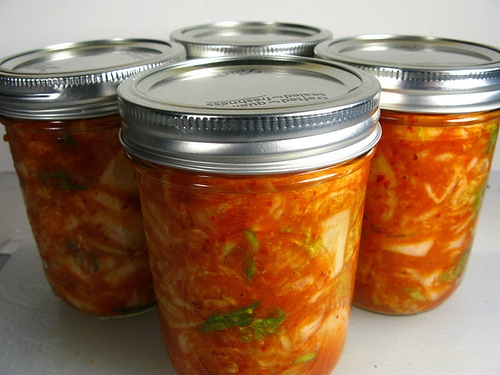 Kimchi.Photo: Julia FrostOn my watch, DIY food preservation has been making its way back into the American kitchen for around half a decade now. And while homemade jam and tomato sauce are easy for most people to love, fermented foods like raw sauerkraut, kimchi, and pickles are a much harder sell. But here in the Bay Area that appears to be changing rapidly. For one, it seems like a new brand of sauerkraut or kombucha pops up monthly, and one could probably find a fermentation class or workshop to attend nearly weekly (there’s one with fermentation demigod Sandor Katz, aka Sandorkraut, in March, that is probably already close to selling out). Don’t believe me? Well, let’s just say I was just invited to my first holiday kimchi-making party (guests were asked to bring cutting board, a big knife, and a mason jar). Would that have happened even two years ago? Unlikely.
Kimchi.Photo: Julia FrostOn my watch, DIY food preservation has been making its way back into the American kitchen for around half a decade now. And while homemade jam and tomato sauce are easy for most people to love, fermented foods like raw sauerkraut, kimchi, and pickles are a much harder sell. But here in the Bay Area that appears to be changing rapidly. For one, it seems like a new brand of sauerkraut or kombucha pops up monthly, and one could probably find a fermentation class or workshop to attend nearly weekly (there’s one with fermentation demigod Sandor Katz, aka Sandorkraut, in March, that is probably already close to selling out). Don’t believe me? Well, let’s just say I was just invited to my first holiday kimchi-making party (guests were asked to bring cutting board, a big knife, and a mason jar). Would that have happened even two years ago? Unlikely.
Up later this week: a list of the year’s top stories in food politics.
